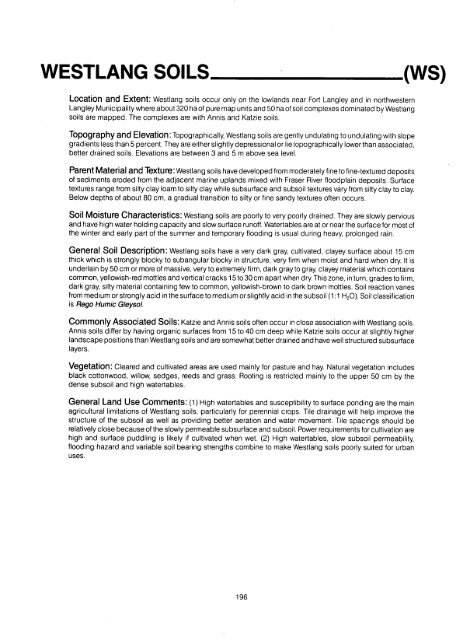Soils of the - Agriculture and Agri-Food Canada
Soils of the - Agriculture and Agri-Food Canada
Soils of the - Agriculture and Agri-Food Canada
You also want an ePaper? Increase the reach of your titles
YUMPU automatically turns print PDFs into web optimized ePapers that Google loves.
WESTLANG SOILS .<br />
(WS)<br />
Location <strong>and</strong> Extent : Westlang soils occur only on <strong>the</strong> lowl<strong>and</strong>s near Fort Langley <strong>and</strong> in northwester n<br />
Langley Municipality where about 320 ha <strong>of</strong> pure map units <strong>and</strong> 50 ha <strong>of</strong> soil complexes dominated by Westlan g<br />
soils are mapped . The complexes are with Annis <strong>and</strong> Katzie soils .<br />
Topography <strong>and</strong> Elevation : Topographically, Westlang soils are gently undulating to undulating with slop e<br />
gradients less than 5 percent . They are ei<strong>the</strong>r slightly depressional or lie topographically lower than associated ,<br />
better drained soils . Elevations are between 3 <strong>and</strong> 5 m above sea level .<br />
Parent Material <strong>and</strong> Texture : Westlang soils have developed from moderately fine to fine-textured deposit s<br />
<strong>of</strong> sediments eroded from <strong>the</strong> adjacent marine upl<strong>and</strong>s mixed with Fraser River floodplain deposits . Surface<br />
textures range from silty clay loam to silty clay while subsurface <strong>and</strong> subsoil textures vary from silty clay to clay .<br />
Below depths <strong>of</strong> about 80 cm, a gradual transition to silty or fine s<strong>and</strong>y textures <strong>of</strong>ten occurs .<br />
Soil Moisture Characteristics : Westlang soils are poorly to very poorly drained . They are slowly perviou s<br />
<strong>and</strong> have high water holding capacity <strong>and</strong> slow surface run<strong>of</strong>f . Watertables are at or near <strong>the</strong> surface for most o f<br />
<strong>the</strong> winter <strong>and</strong> early part <strong>of</strong> <strong>the</strong> summer <strong>and</strong> temporary flooding is usual during heavy, prolonged rain .<br />
General Soil Description : Westlang soils have a very dark gray, cultivated, clayey surface about 15 c m<br />
thick which is strongly blocky to subangular blocky in structure, very firm when moist <strong>and</strong> hard when dry . It i s<br />
underlain by 50 cm or more <strong>of</strong> massive, very to extremely firm, dark gray to gray, clayey material .which contain s<br />
common, yellowish-red mottles <strong>and</strong> vertical cracks 15 to 30 cm apart when dry . This zone, in turn, grades to firm ,<br />
dark gray, silty material containing few to common, yellowish-brown to dark brown mottles . Soil reaction varie s<br />
from medium or strongly acid in <strong>the</strong> surface to medium or slightly acid in <strong>the</strong> subsoil (1 :1 H 2 O). Soil classification<br />
is Rego Humic Gleysol.<br />
Commonly Associated <strong>Soils</strong> : Katzie <strong>and</strong> Annis soils <strong>of</strong>ten occur in close association with Westlang soils .<br />
Annis soils differ by having organic surfaces from 15 to 40 cm deep while Katzie soils occur at slightly highe r<br />
l<strong>and</strong>scape positions than Westlang soils <strong>and</strong> are somewhat better drained <strong>and</strong> have well structured subsurfac e<br />
layers .<br />
Vegetation : Cleared <strong>and</strong> cultivated areas are used mainly for pasture <strong>and</strong> hay . Natural vegetation include s<br />
black cottonwood, willow, sedges, reeds <strong>and</strong> grass . Rooting is restricted mainly to <strong>the</strong> upper 50 cm by th e<br />
dense subsoil <strong>and</strong> high watertables .<br />
General L<strong>and</strong> Use Comments : (1) High watertables <strong>and</strong> susceptibility to surface ponding are <strong>the</strong> mai n<br />
agricultural limitations <strong>of</strong> Westlang soils, particularly for perennial crops . Tile drainage will help improve th e<br />
structure <strong>of</strong> <strong>the</strong> subsoil as well as providing better aeration <strong>and</strong> water movement . Tile spacings should b e<br />
relatively close because <strong>of</strong> <strong>the</strong> slowly permeable subsurface <strong>and</strong> subsoil . Power requirements for cultivation ar e<br />
high <strong>and</strong> surface puddling is likely if cultivated when wet . (2) High watertables, slow subsoil permeability ,<br />
flooding hazard <strong>and</strong> variable soil bearing strengths combine to make Westlang soils poorly suited for urba n<br />
uses .<br />
196

















